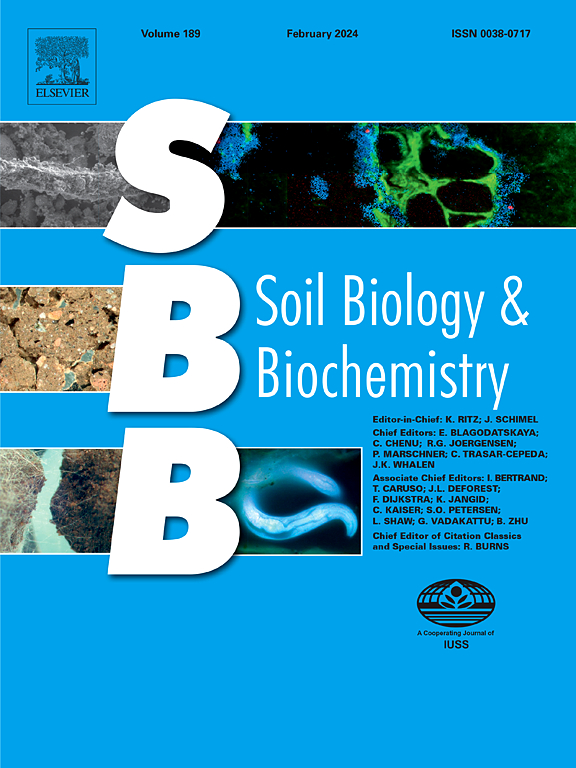Soil pH promoted respiration is stimulated by exoenzyme kinetic properties for a Pinus tabuliformis forest of northern China
IF 9.8
1区 农林科学
Q1 SOIL SCIENCE
引用次数: 0
Abstract
The trends in 21st century climate change will be largely modulated by the amount of carbon respired via the enzymatic depolymerization of soil organic carbon (SOC). As soil pH serves as a key indicator of global change, understanding how soil respiration responds to pH induced changes in enzyme kinetic properties will provide valuable insights into the feedback of soil carbon to climate change. In a Pinus tabuliformis forest of northern China, a soil pH gradient ranging from 4.91 to 7.89 was constructed by applying ammonium nitrate at rates of 5, 10, 20, and 40 g N m−2 yr−1 (N5, N10, N20, and N40) and lime at rates of 50, 100, 200, and 400 g m−2 yr−1 (L50, L100, L200, and L400) since 2015. In August 2022, soil basal respiration, the β-glucosidase (BG) activity, and soil microbial properties were measured. Results revealed that soil basal respiration increased from 1.46 μmol CO2 m−2 s−1 in N40 treatment to 2.36 CO2 m−2 s−1 in L400 treatment, while the binding affinity of BG rose from 0.018 to 0.032 under the same treatments. The maximum activity of BG decreased from 119.82 nmol MUB·h−1·g−1 SOM in N40 treatment to 66.80 nmol MUB·h−1·g−1 SOM in L400 treatment. The temperature sensitivity of soil respiration showed a bell-shaped response to soil pH, with an optimal pH of about pH 6.7. Our findings demonstrated that it was the binding affinity instead of the activity of BG that positively promoted soil respiration across the established soil pH gradient. The underpinning mechanisms linking soil respiration with enzyme functions were ascribed to the soil acid-base microenvironment, which affected the bioavailability of key nutrient and the content of soil inorganic nitrogen. Additionally, these results will improve the understanding of enzymatic mechanisms in driving the biogeochemical cycle of SOC.
油松林土壤pH促进呼吸作用的外酶动力学特性研究
21世纪气候变化的趋势将在很大程度上受到土壤有机碳酶解聚合所呼吸的碳量的调节。由于土壤pH值是全球变化的关键指标,了解土壤呼吸如何响应pH值引起的酶动力学性质的变化将为土壤碳对气候变化的反馈提供有价值的见解。2015年以来,通过施用5、10、20和40 g N - m-2年-1 (N5、N10、N20和N40)的硝酸铵和施用50、100、200和400 g N - m-2年-1 (L50、L100、L200和L400)的石灰,在中国北方油松森林中构建了4.91 ~ 7.89的土壤pH梯度。2022年8月,测定了土壤基础呼吸、β-葡萄糖苷酶(BG)活性和土壤微生物特性。结果表明,N40处理的土壤基础呼吸从1.46 μmol CO2 m-2 s-1增加到L400处理的2.36 μmol CO2 m-2 s-1,而BG的结合亲和力从0.018增加到0.032。BG的最大活性由N40处理的119.82 nmol MUB·h-1·g-1 SOM降至L400处理的66.80 nmol MUB·h-1·g-1 SOM。土壤呼吸的温度敏感性对土壤pH呈钟形响应,最佳pH值约为pH 6.7。我们的研究结果表明,在既定的土壤pH梯度中,是结合亲和力而不是BG的活性积极促进了土壤呼吸。土壤酸碱微环境影响土壤关键养分的生物有效性和土壤无机氮含量,是土壤呼吸与酶功能联系的基础机制。此外,这些结果将提高对酶驱动有机碳生物地球化学循环机制的理解。
本文章由计算机程序翻译,如有差异,请以英文原文为准。
求助全文
约1分钟内获得全文
求助全文
来源期刊

Soil Biology & Biochemistry
农林科学-土壤科学
CiteScore
16.90
自引率
9.30%
发文量
312
审稿时长
49 days
期刊介绍:
Soil Biology & Biochemistry publishes original research articles of international significance focusing on biological processes in soil and their applications to soil and environmental quality. Major topics include the ecology and biochemical processes of soil organisms, their effects on the environment, and interactions with plants. The journal also welcomes state-of-the-art reviews and discussions on contemporary research in soil biology and biochemistry.
 求助内容:
求助内容: 应助结果提醒方式:
应助结果提醒方式:


